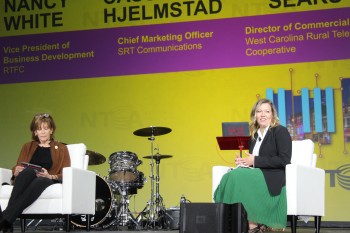The 2021 Fall Conference continued in Nashville with various educational sessions geared toward setting members up for success in their communities and analyzing the legislative and regulatory issues that will affect the industry over the next decade.
Bill Esbeck, executive director of the Wisconsin Telecommunications Association, led a panel on how broadband providers can partner with realtors on creative solutions to help foster a rural renaissance and maximize the use of fiber. He noted that while realtors had rebuffed his own proposals a few years ago, after the pandemic they are now eager to partner.
Chad Young, chief executive officer of Norvado (Cable, Wis.), shared that his company provides toolkits to realtors, as well as yard signs, sell sheets, and a website that lets them look up the fiber status of a property. He credited Norvado’s strong fiber connections with playing a role in people opting to live at their vacation homes up to a week and a half longer each year.
Justin Huebner, general manager of Solarus (Wisconsin Rapids, Wis.), said the company’s investment in fiber a few years ago enabled some people to relocate to their second homes, leading Solarus to achieve a 5% growth in customers.
Recruiting for the Renaissance
The American workforce has endured a lot of disruption in the last year and a half, and while employees have adjusted to a new normal, as many as 75% of workers say they plan to leave their jobs this year.
Rebecca Battle Bryant from Battle Plan Consulting talked about how to find and keep good employees amidst the turnover tsunami as a “Silver Exodus” is seeing Gen X employees retire earlier than expected. Attendees were encouraged to improve their recruiting by being aware of their reputation and by holding onto current employees by conducting “stay interviews” and giving recognition to employees who stay with the company.
Bryant also told attendees that it will be important for their companies to be disruption-proof by helping employees upskill and develop cross-functional skillsets. A shorter recruitment process will also be key, enabled by tools such as video interviews, passive applicant marketing, and applicant tracking technology.
Broadband Policy for the Next Decade
As broadband continues to be a top issue for Americans and lawmakers from both parties, the amount of funding and programs geared toward expanding access continues to grow. This increased attention is helpful but it is also not without its challenges as new entrants compete for funding and as various agencies take different approaches to achieving universal access.
Mike Romano, NTCA senior vice president of Industry Affairs and Business Development, talked with three NTCA members about how far the industry has come and where it could be at the end of the decade, noting that companies endured declining access revenues and have performed well in the face of the National Broadband Plan.
Catherine Moyer, chief executive officer of Pioneer Communications (Ulysses, Kan.), shared that she believes the future will involve edging out to new areas and working with other companies on scale and size, which will be important as more outside money comes into the industry and partnerships form.
Dustin Durden, general manager of Pineland Telephone Cooperative (Metter, Ga.) said that the company remained committed to fiber builds over the last decade as it lost 4% of access lines but saw 30% growth in internet service. He also credited the ACAM program with providing stable funding which enabled the company to make informed decisions.
Rob Johnstone, chief executive officer of Range (Forsyth, Mont.), also credited ACAM with providing stability in budgeting and planning for his network, which serves a 30,000 square mile area.
All three agreed that lawmakers and regulators should start focusing on ensuring that funding is available to maintain new networks, and that permitting delays do not get in the way of reaching more unserved communities. They also agreed that further Universal Service Fund reform is needed, dovetailing with the USForward report released by NTCA and several other organizations last week.
Smart Rural Community - You Did the Work, Now Tell Your Story
NTCA’s Smart Rural Community program has grown rapidly, with 170 companies now taking part, 30 of which joined in 2021. With the addition of the Smart Tribal Community and Smart Connected Community brands, there is an opportunity for every NTCA member.
During a panel on Wednesday, Cassidy Hjelmstad, incoming chief executive officer of SRT Communications (Minot, S.D.), encouraged members to signup at NTCA.org/smart. Shannon Sears, director of commercial operations for West Carolina Rural Telephone Cooperative (Abbeville, S.C.), said that companies do not need a large marketing department to make the program work thanks to the marketing and social media toolkit created by NTCA.
Current and interested SRC companies were also invited to attend SRC Live! on December 6-7, in Charlotte, N.C., which will showcase the broadband-enabled applications rural communities can leverage to foster innovative economic development, education, health care, agriculture and other vital services.



